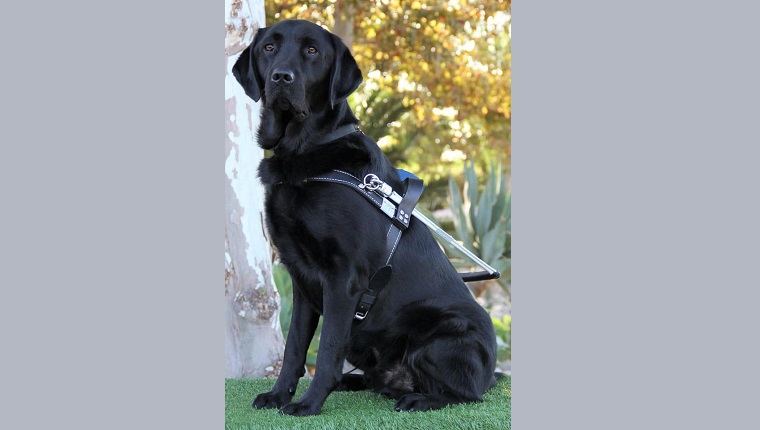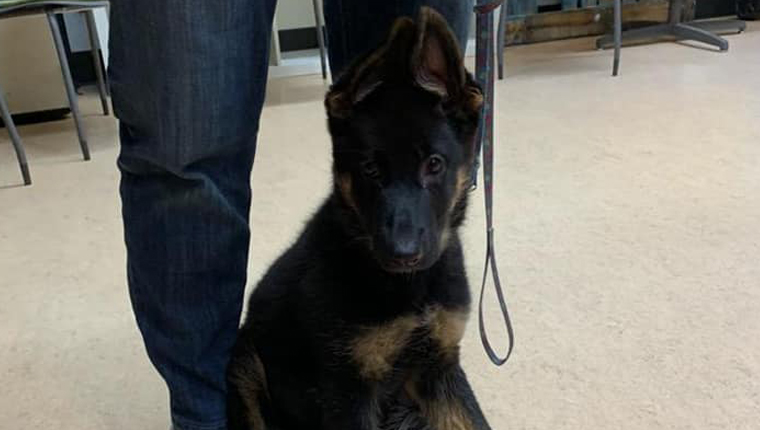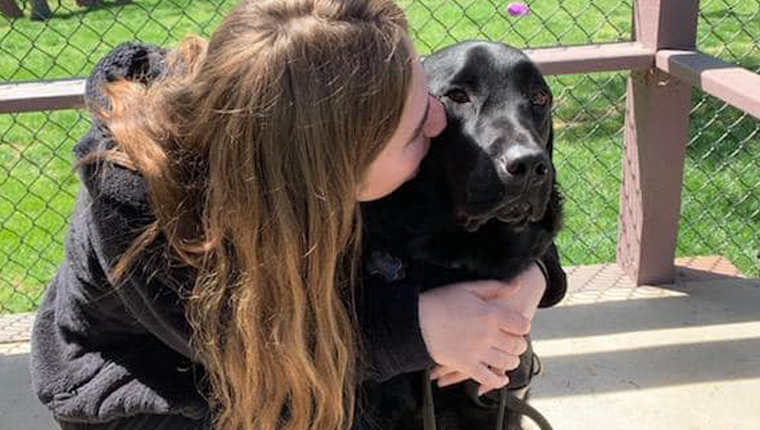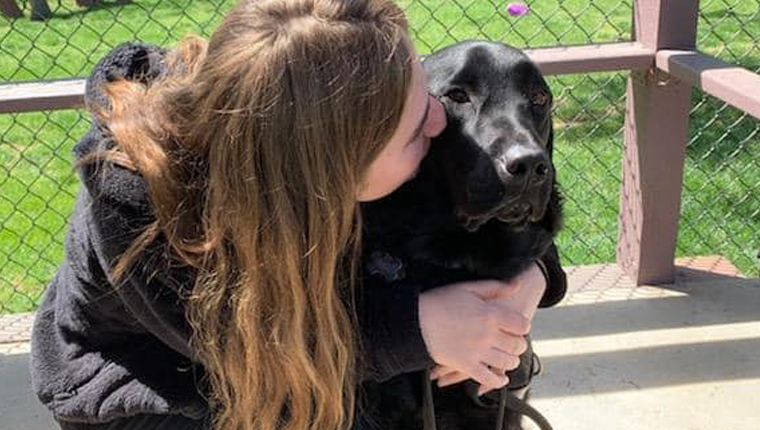
You may have already heard of Guide Dogs of America and the work they do. Headquartered in Sylmar, California, their main purpose is to place highly trained guide dogs into the homes of people who are blind or visually impaired so that they may live their lives more independently.
For a person who’s visually impaired, there is no end to what they can do with a little help from a guide dog.
Puppy raising is an important part of the process for the Guide Dogs Of America. Training one guide dog is costly and rigorous, so volunteer puppy raisers play an integral role. At eight weeks old, puppies go into homes where they learn socialization and many basic training lessons.
That’s where people like Mary come in. Mary raises puppies so they can grow up to be well-behaved, socialized guide dogs for people in need.
Puppy Raising Is A Process

The puppy in the picture above is Zuri. She’s Mary’s second puppy in training.
Guide dog puppies stay with their “puppy raisers” for approximately 16 to 18 months before moving on to “college,” which includes four to six months of intensive training. When the dogs are ready, they’re placed with their person. The pups are periodically assessed, and handlers must attend weekly classes to help their pup stay on task.
Mary, has already successfully raised one puppy who recently graduated, and a new puppy was just placed in her expert care. I wanted to ask her some questions about her work with Guide Dogs of America and the process of raising puppies to be guide dogs.
What Inspires Someone To Be A Guide Dog Puppy Raiser?
Puppies are doggone cute, but adopting a dog comes with many years of commitment. Raising a puppy through Guide Dogs Of America serves a greater purpose. I asked Mary about her start as a puppy raiser.
JULIA: How did you hear about Guide Dogs of America?
MARY: I first heard about Guide dogs of America from my neighbor, who raised them for many years. This was a long time ago, so when I wanted a puppy but wanted to do something good for people, I circled back to Guide Dogs.
JULIA: Why did you want to become a puppy raiser?
MARY: I wanted to become a puppy raiser because, bottom line, I really wanted a puppy. But, I didn’t just want to get another dog, I wanted to do something good. I wanted to have a dog who had meaning and purpose beyond just lying around, and becoming a puppy raiser did just that.
What Does A Puppy Raiser Do?
JULIA: What is the most important job for puppy raisers?
MARY: The most important job that a puppy raiser has is giving the puppy a loving home and exposing them to the world. They don’t get the same love and exposure from living in a kennel, so we, the puppy raisers, give them what they would lack in the kennel.
JULIA: Do you get to name your puppy? How does that work?
MARY: You do get to name your puppy, but with some restrictions. Each litter born at Guide Dogs is assigned a letter, which helps the staff keep track of ages of puppies and siblings.
So when naming your puppy, you have to have the name start with the letter of their litter. For example, Newt was an N litter, so we named him Newt and his sister was named Nora and so on.
JULIA: Are pups punished when they do bad or only praised when they do good?
MARY: The training at GDA is all praise based. We don’t “punish” our dogs but instead praise for good behavior. We use positive reinforcement with treats–mainly when they are younger–and verbal/physical praise.
JULIA: How often are the the pups assessed?
MARY: The first assessment the puppies receive is while they are still at Guide Dogs before they are given to raisers–about seven weeks. There they test them for many things like temperament and sound sensitivity.
After that, there aren’t a lot of formal assessments–I think another when they’re about six months, just to see if they are on track until they go off to college for training. There they get assessed when they first come in and a final big one to determine if they are ready to be matched with their person.
Training In Public–Difficult But Necessary

I’ve been guilty of wanting to pet a service dog or dog in training, so I wanted to address that and let people know that, if you see a dog wearing a vest, approach the handler first. Very often they are sympathetic to the plight of people who love petting pups!
JULIA: Do the dogs wear any kinds of training vests when in public?
MARY: When in public, the dogs wear a yellow vest that says “guide dog puppy in training.” This does two things–it tells people and stores that this isn’t a normal dog, but it also gets the dog used to wearing something similar to the harness they will wear when they are a real guide dog.
JULIA: When you are in public, do people respect that the pup is in training, or do some people just see a puppy that they would like to pet? Are people allowed to pet the puppies? Have there been any challenges in public settings in that regard?
MARY: Most people respect the puppies in training and ignore them or at least ask before petting. Others sometimes don’t really listen when asked not to pet. People are allowed to pet but only when it’s a controlled environment.
The pups are taught two commands, “Go Say Hi” and “Sit For Greeting.” Go Say Hi–the dog is allowed to stand and go to the person to be pet for a few seconds, then they are called back to the handler. Sit For Greeting is where the dog must remain seated, and the person can come over and pet the dog.
For the most part people are very respectful and they always love to hear about guides. I always love talking to people about the program and puppies.
Not All Puppies Are Made For Guide Dog Work
JULIA: What happens to puppies who aren’t cut out to be Guide Dogs?
MARY: We call those dogs career change dogs. They are first offered to their puppy raisers who can accept and have that dog as a pet, but if they don’t want the dog, the dog is given to someone on a long waiting list.
These dogs are great dogs, so a lot of people want them. This waiting list takes an average of about two years, but it could take longer or shorter. The easiest way to get a dog as a pet from this program is to puppy raise because, if they are dropped, you’re the first person they call.
You Can Be A Puppy Raiser, Too!
JULIA: You are training your second dog, and your first dog just graduated. What would you tell a person who wants to become a puppy raiser? Do you have any tips or advice?
MARY: I would 100 percent recommend raising a puppy. Seeing Newt with his person was such a happy and fulfilling moment that I can’t describe. We loved it so much we got a second!
My advice would be to make sure you’re ready to take on a puppy before you sign up because, though it was a wonderful experience, it was a lot of hard work, so you have to be ready for that.
How To Get Involved
If you’re interested in becoming a puppy raiser for Guide Dogs of America, you should check out their website for more resources:
They are currently looking for locals in California to volunteer as puppy raisers.
Since beginning my interview, I’ve actually looked into puppy raising for myself. I’m not located in California anymore, but I did find a place that needs puppy raisers for companion dogs for veterans near me. It requires that I attend several classes first.
I’ll keep you updated if I become a puppy raiser, myself!
But if you’re not located in California, like me, you can look for similar programs near you. Search for local service dog groups and see if they have any volunteer opportunities. You can help raise puppies for a greater purpose, too!
Do you know any puppy raisers? Do you have any friends who would make excellent puppy raisers? Let us know in the comments below and share this story. Maybe someone you know will become a puppy raiser, too!
Related Articles:
How To Volunteer At An Animal Shelter
5 Best Service Dog Breeds For Those With Disabilities Or Medical Conditions




